Within the past couple years, the Navy has made changes to the enlisted seabag in part to the response to feedback leadership was receiving from the Sailors in the fleet. These changes have come with mixed feelings from the Sailors who currently serve and a lot of negative feedback from those who served prior. So has the Navy gone to far and broken with tradition with the ‘radical’ changes with the uniforms? I don’t think so…I think the more things change the more they stay the same. Change is the one constant that the Navy has known since its inception in 1775.
Things are ALWAYS changing and that means the service is evolving and remaining strong. The technology, the tactics and yes even the uniforms have ALL been revised since the Navy was created. Technology and tactics seem to be readily accepted as a better way of doing business but somehow people dig in their heels when it comes to uniforms. In each era the Navy made adjustments to its uniforms for usability, protection and of course cost factored in as well.
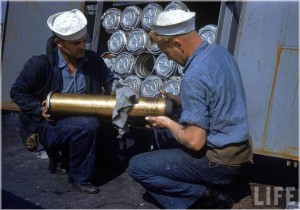 |
| Sailors wearing the ‘traditional’ sailor dungaree uniform with ‘white hats’ |
The traditional uniform it seems most people think of when they refer to Sailors are either the dungaree uniform a.k.a. the ‘bell bottom jeans’ or the Service Dress Blues more commonly known as the ‘crackerjacks’. The dungaree work uniform was a simple uniform made of a chambray cotton shirt and boot-cut, denim trousers (to help sailors don them while still wearing their boots) that could hold up to the grimy and greasy environments aboard ship. This uniform was originally introduced in the uniform regulations in 1901 and was worn below decks by officers and enlisted alike by 1913. The officers and Chief Petty Officers eventually transitioned to the khaki uniform and the utility uniform was eventually updated in the mid 1990s to a straight-legged chino cloth trouser, poly cotton shirt with embroidered name tapes, and rank insignia for a more polished and uniform appearance. The white hat was no longer authorized to be worn and instead was replaced by a command ball cap.
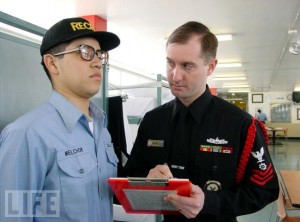 |
| Sailor Recruit wearing the utility uniform with ball cap gets inspected |
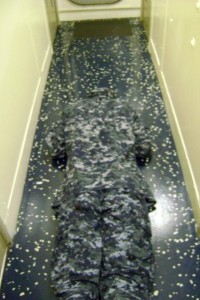 |
So with the knowledge that change truly is the constant in the Navy, it seems odd that so many ‘old salts’ have had issues with the new Navy Work Uniform (NWU). The NWU is a working uniform designed to replace the traditional utility uniform as well as the coveralls. Upon first glance many find the color scheme to seem silly as camouflage is not required at sea. Although as this Sailor in the picture on the right has shown, it might be helpful when you’re in trouble with the Chief or Division Officer.
But in all seriousness, the NWU colors are based upon the common paint colors that are utilized in a shipboard environment. Having a ‘digital’ scheme using these colors is actually supposed to help mask the permanent soil caused through the regular wear and tear. Additionally reducing from two uniforms to one is more cost effective and makes a lighter sea bag. The NWU is one of several uniforms to come out from the CNO’s Task Force Uniform imitative in which feedback from the Sailors in the fleet help mold the uniform policies put into place. Upon closer inspection of the uniform elements other than just color have been designed into the pattern to ensure ties to tradition (in much the same way as the Marines did with their MARPAT uniform).
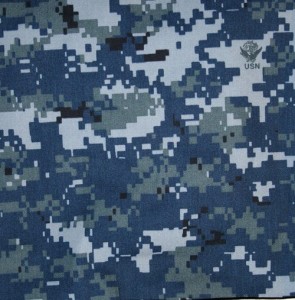 |
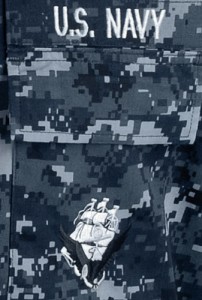 |
Like the overall pattern, the right pocket also displays icons of the Naval Service. The USS Constitution, an anchor and an eagle.
So while this might seem like a dramatic departure from ‘tradition’, let’s truly put that into perspective. The uniforms that the Navy has issued since its inception would probably be considered archaic by today’s standards but during their time were viewed as very progressive and potentially radical.
When the Navy decided to allow women to serve during the war to offset the shortage of men, a uniform had to be developed for women. These WAVES (Woman Accepted for Volunteer Emergency Service) were not only pioneers for womens rights but test cases for new uniforms. Later when women were full accepted into the military services, the uniforms became standardized for men as well as women as is shown below by the female recruits in formation at Recruit Training Center Great Lakes, IL.
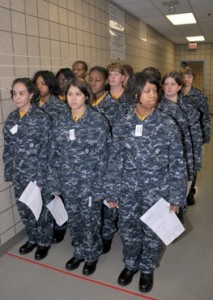 |
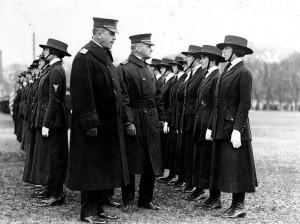 |
|
| New female Recruits in ranks | WAVES in ranks during Inspection |
Hopefully through a quick glimpse in history it becomes apparent that change truly is a major constant in the Navy’s history and the willingness to adopt new changes is what makes the U.S. Navy so strong. By embracing change instead of fearing it we are actually embracing our heritage of Honor, Courage and Commitment.
It all comes down to one simple statement: A Sailor is a Sailor no matter which uniform he/she wears as long as it is worn with pride.
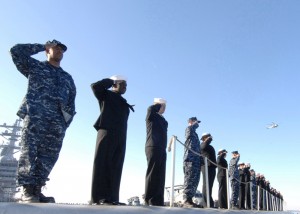 |
